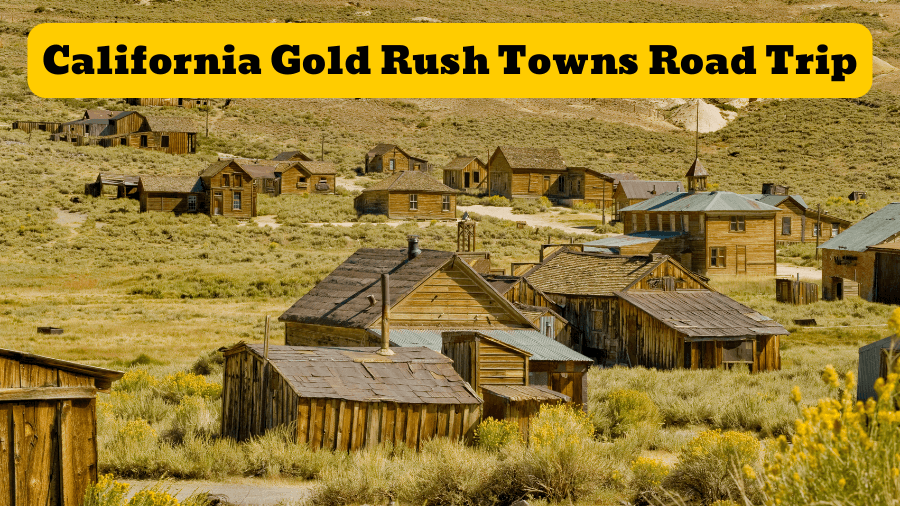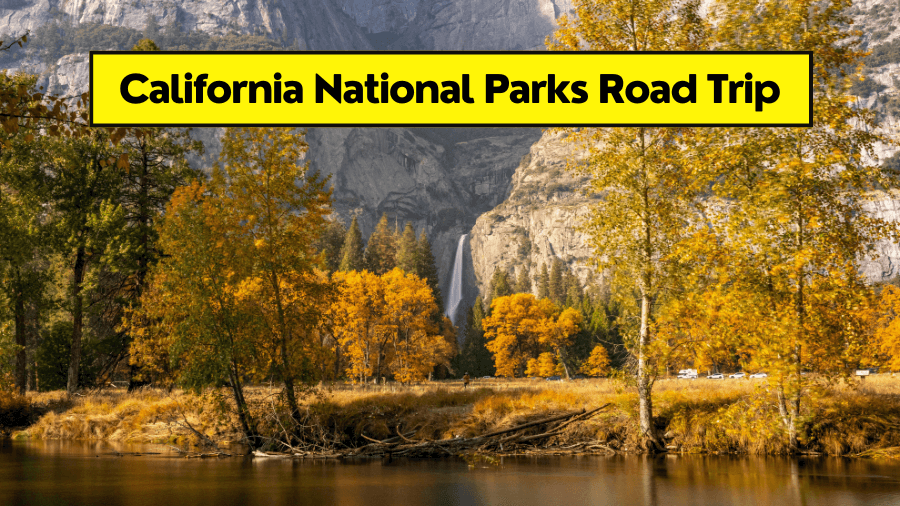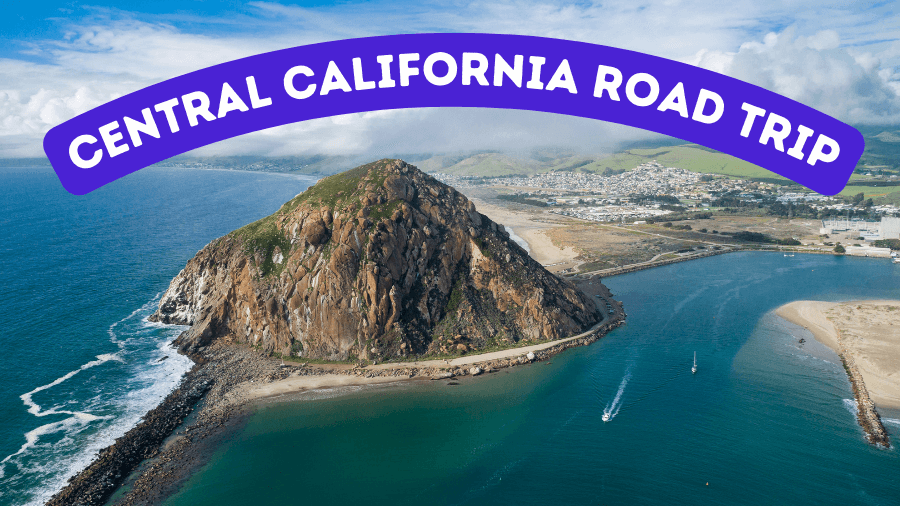If you’ve ever dreamed of striking it rich, this road trip is the next best thing.
We’re talking about a journey through California’s most legendary Gold Rush towns—places where miners once gambled their fortunes, saloons stayed open all night, and dusty trails led to hidden pockets of gold.
Some of these towns are still buzzing with life, packed with historic buildings, museums, and even gold panning spots where you can test your luck.
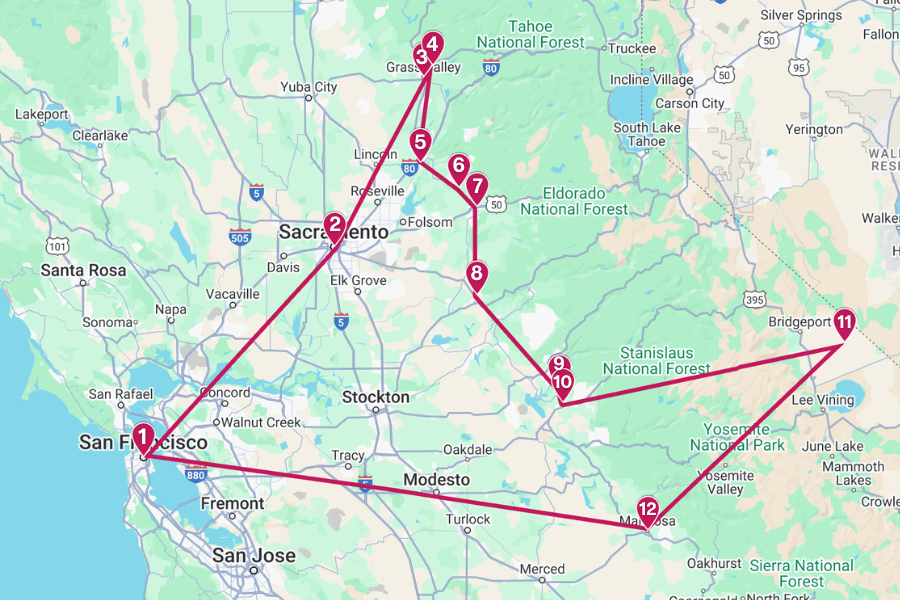
Others? Totally abandoned, frozen in time like the miners just vanished, leaving behind eerie ghost towns and crumbling saloons.
Along the way, you’ll find old mines, Wild West hotels, and maybe even a few haunted spots (because what’s a Gold Rush town without a good ghost story?).
1. San Francisco
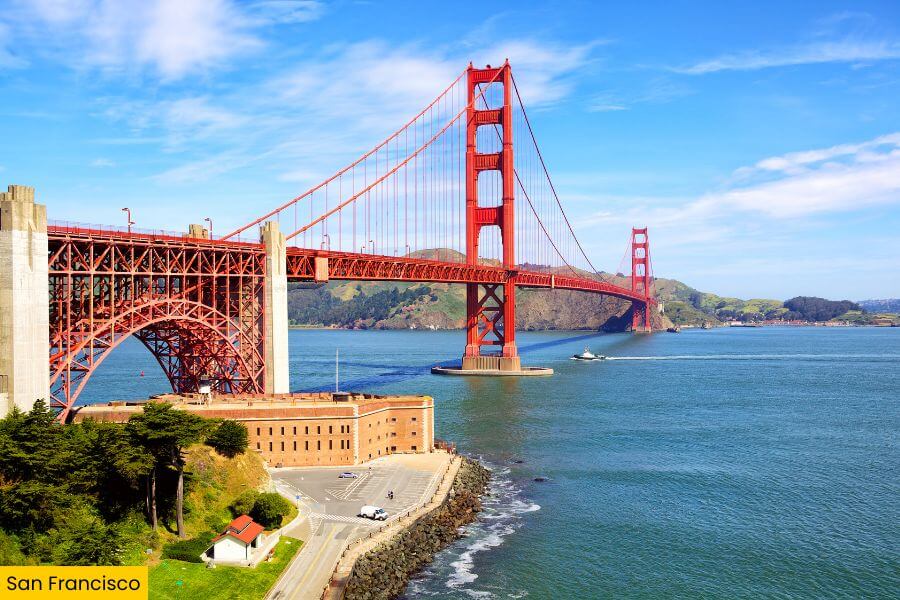
San Francisco was the ultimate boomtown of the Gold Rush, exploding from a tiny village to a chaotic, gold-fueled city almost overnight.
If you want to see where it all began, head to Portsmouth Square, the old heart of Gold Rush San Francisco, where fortune seekers once camped out with dreams of striking it rich.
For a real taste of history, stop by the Fort Point National Historic Site—a remarkable landmark from San Francisco’s Gold Rush era, built in the 1850s to protect the city.
And if you love a good ghost story, the city’s old Gold Rush-era buildings—like the historic Jackson Square saloons—still carry echoes of the rowdy, lawless days when prospectors and con men ruled the streets.
2. Sacramento
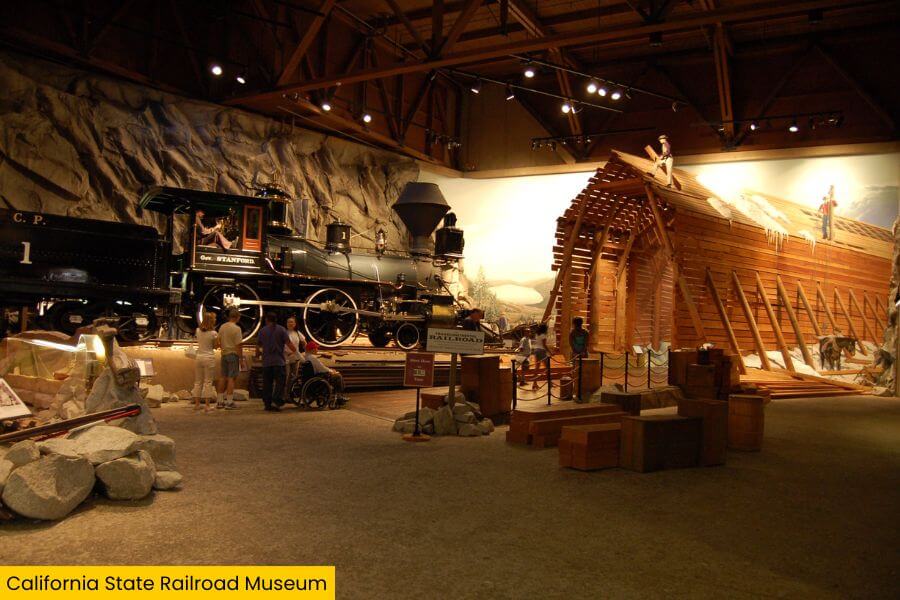
Sacramento, the capital of California, was ground zero for Gold Rush supply runs, thanks to its prime spot on the American River.
This is where miners loaded up on picks, pans, and pure optimism before heading into the hills, and you can still see that history come to life in Old Sacramento.
The California State Railroad Museum is a must if you want to see how trains helped transform this dusty mining outpost into a booming hub for gold and goods.
And for a true Gold Rush throwback, you can tour the underground tunnels beneath the city.
3. Grass Valley

Grass Valley, up in Nevada County, wasn’t just another Gold Rush town—it was home to some of the richest gold mines in California.
The Empire Mine, which you can still visit today, churned out nearly 5.8 million ounces of gold and has tunnels that stretch for over 367 miles underground.
Downtown Grass Valley keeps the old mining spirit alive with historic brick buildings, antique shops, and the Holbrooke Hotel, a saloon-turned-hotel that once served whiskey to Mark Twain and Ulysses S. Grant.
And if you’re craving a treat, stop by Marshall’s Pasties where they serve true Cornish pasties—just like the ones that Cornish women of the past fed to hungry miners.
4. Nevada City

Just a few miles from Grass Valley, Nevada City feels like stepping straight into a time capsule, with its perfectly preserved 1800s buildings and old-time charm.
You can still catch a glimpse of its wild past at the National Exchange Hotel, one of California’s oldest operating hotels, where miners once made (and lost) fortunes over a game of cards.
For a deeper dive into history, the Nevada County Narrow Gauge Railroad Museum tells the story of how steam trains hauled gold, lumber, and passengers through these rugged hills.
If you’re visiting in June, don’t miss the Nevada City Film Festival—because nothing says “Old West mining town” like an indie film fest in a Victorian-era theater.
5. Auburn

Auburn, sitting in Placer County, is pure Gold Rush legend—it’s one of the only towns that still has gold miners working its hills today.
This place boomed in 1848 when prospectors struck gold in the Auburn Ravine.
You can relive history at the Placer County Museum, where you’ll find real Gold Rush artifacts, including miner’s tools and even a full-scale replica of an old mining camp.
The town square is hard to miss, thanks to the massive statue of Claude Chana, the French miner who first discovered gold here—he’s forever frozen mid-scoop, panning for gold like it’s still 1848.
Auburn is also the gateway to some serious outdoor fun, with gold panning tours along the American River and many hiking trails.
6. Coloma

Coloma is where it all began—this tiny spot in El Dorado County is the exact place where gold was first discovered in California in 1848.
You can stand right where history changed forever at Marshall Gold Discovery State Historic Park, home to a replica of Sutter’s Mill, the sawmill where James Marshall spotted those game-changing gold flakes in the river.
The park is packed with old mining equipment, historic buildings, and even hands-on gold panning, so you can try your luck just like the first prospectors (spoiler: it’s harder than it looks).
And if you need a break from all the gold fever, the South Fork of the American River runs right through town, making Coloma a top spot for whitewater rafting.
7. Placerville
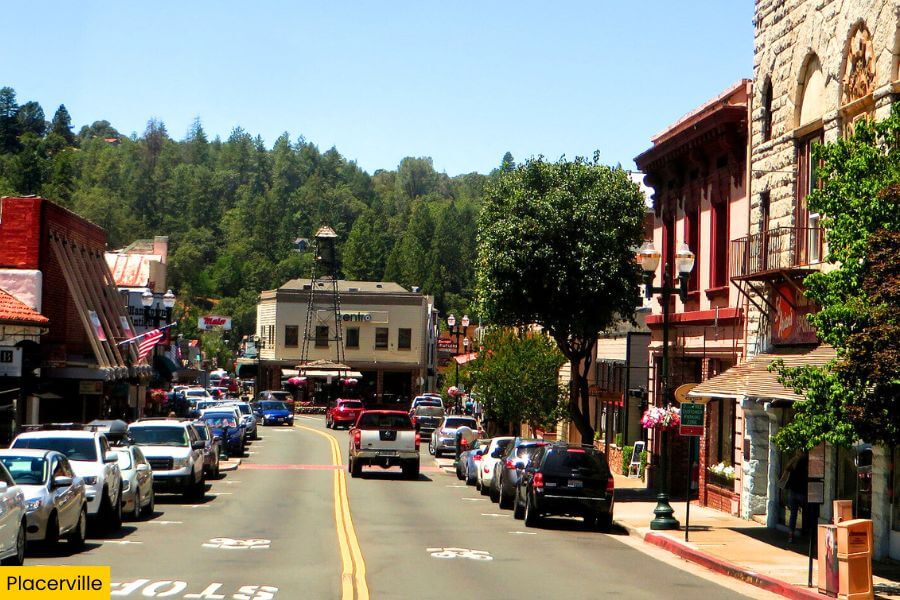
Placerville, just down the road from Coloma, was once so wild it earned the nickname “Hangtown” thanks to its Gold Rush-era justice system (spoiler: it involved a lot of rope).
These days, the only thing swinging in town are the saloon doors at spots like the historic Cary House Hotel, where gold miners, outlaws, and even Mark Twain once stayed.
For a true blast from the past, stop by Gold Bug Park & Mine, where you can actually walk into a real hard-rock mine and see how fortune-seekers blasted through mountains in search of gold.
And if you’re hungry, head to Buttercup Pantry for a Hangtown Fry—a legendary Gold Rush-era dish.
8. Sutter Creek
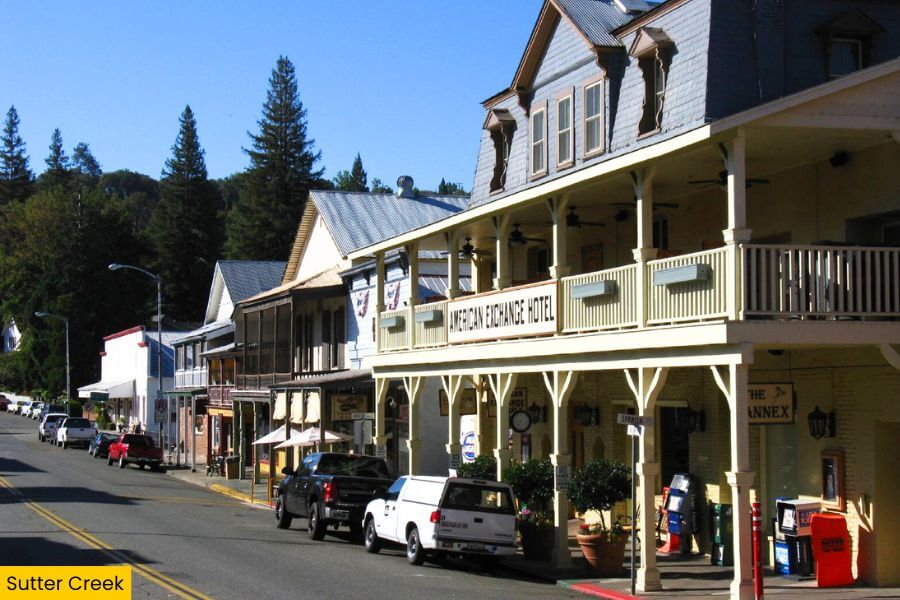
Sutter Creek, in Amador County, is pure Gold Rush charm, with its perfectly preserved Main Street lined with 1800s buildings, old saloons, and family-run shops.
This town became one of the richest quartz mining areas in California.
Nearby, you can tour Kennedy Gold Mine in Jackson, where miners dug thousands of feet into the earth hoping to strike it big.
If you’re up for a little treasure hunting of your own, the antique stores here are packed with everything from vintage gold scales to old prospector tools.
Sutter Creek is also in the middle of Amador Wine Country, meaning you can swap gold panning for wine tasting at one of the local vineyards—because let’s be real, that’s a way better way to strike gold.
9. Columbia

Columbia, in Tuolumne County, isn’t just a Gold Rush town—it’s a full-on time machine.
As part of Columbia State Historic Park, this place is frozen in the 1850s, with dirt roads, wooden storefronts, and costumed shopkeepers who look like they just stepped out of a wagon.
You can pan for gold, ride an old stagecoach (complete with a possible “robbery”), and even grab a sarsaparilla at the saloon, just like miners did when they needed a break.
And if you want to spend the night like a true prospector, check into the Fallon Hotel, where the 19th century ambiance and Victorian-era furnishings transport you back in time.
10. Sonora

Sonora, the lively hub of Tuolumne County, was a booming gold mining town built by prospectors from—you guessed it—Sonora, Mexico.
Unlike some Gold Rush towns that feel empty, Sonora is still buzzing with life, especially in its historic downtown, where you’ll find cafés and boutiques.
For a dose of mining history, stop by the Tuolumne County Museum, which was once the county jail.
And if you’re up for an outdoor adventure, Dragoon Gulch Trail gives you a bird’s-eye view of the town and the very hills where miners once dug for treasure.
11. Bodie

Bodie, way out in the high desert of Mono County, is a full-blown ghost town, frozen in time like the miners just up and left one day (which, honestly, they kind of did).
Once home to around 10,000 people, this place was wild, lawless, and packed with more saloons than schools.
But when the gold ran out and fires took their toll, people moved on, leaving behind weathered buildings, dusty streets, and an eerie silence.
Now a state historic park, Bodie is one of the best-preserved ghost towns in the country.
You can peek inside abandoned homes, see rusted mining equipment still sitting where it was last used, and maybe even feel a ghostly chill in the old jailhouse.
And if you’re thinking about pocketing a “souvenir” rock, don’t—legend has it, anyone who steals from Bodie gets cursed with bad luck until they return what they took.
12. Mariposa

Mariposa, tucked into the foothills of Mariposa County, was one of the last stops for miners before they ventured into the wild Sierra in search of gold.
This town takes its Gold Rush history seriously as you can still see one of California’s oldest courthouses (still in use!).
Check out massive gold nuggets at the Mariposa Museum & History Center, or even visit an old stamp mill where ore was crushed into dust to reveal its precious treasure.
Also stop by the California State Mining and Mineral Museum, home to the legendary Fricot Nugget, a 13.8-pound crystalline gold specimen that proves some people really did hit the jackpot.
And while most Gold Rush towns eventually faded into history, Mariposa stayed on the map as the gateway to Yosemite National Park—because if striking gold didn’t work out, at least miners had one of the most breathtaking backyards in the world.
Related Posts

